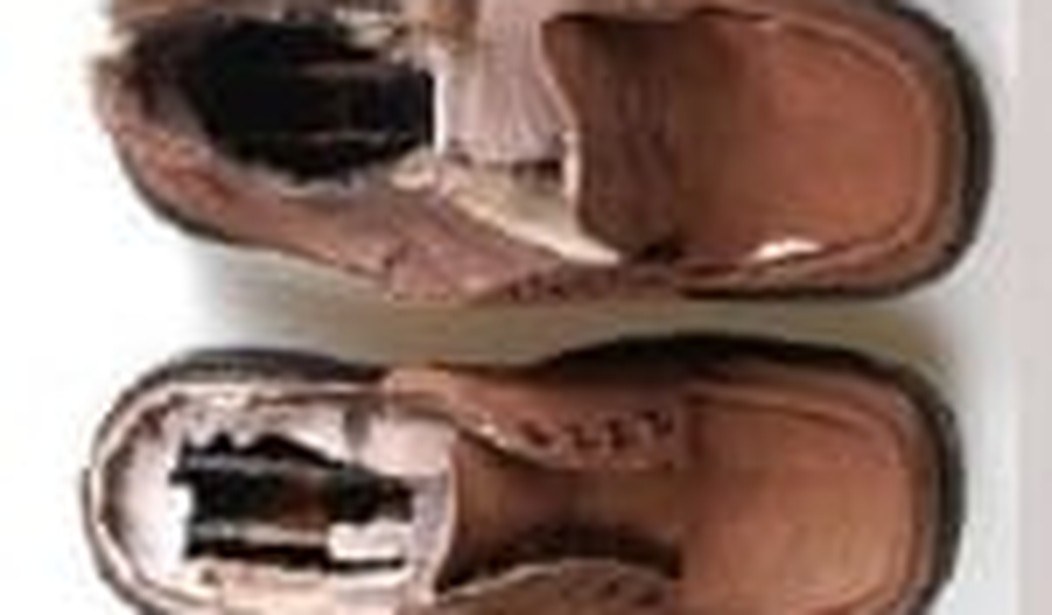Last Friday, a secret, DHS-FBI joint intelligence memo surfaced, alerting airport screeners to be on the lookout for shoe bombs. The alert, titled “Terrorist Use of Modified Footwear to Conceal Explosive Devices,” came on the heels of intelligence gleaned from “European authorities” who, just last month, discovered a suspicious pair of shoes under a bus traveling across international borders. Included with the photograph of the terrorist’s shoes were these details:
The shoes-made of leather with thick rubber soles-were modified so that the insole of each shoe could be removed for access to the hollow interior of the rubber sole. Electric blasting caps were placed inside the hollow rubber sole, and the insole was glued to the rubber sole to appear as if the shoe was never modified.
Sounds pretty terrorist-like, indeed. If you’re one of the approximately two million people who remove their shoes today, and every day, at U.S. airports, knowing terrorists are still at work concealing bombs in shoes might make you feel less likely to argue with airport screeners over the matter. But also in the DHS/FBI memo, intelligence analysts provided airport screeners with a summation of “Potential Indicators of Shoe Tampering” (in case the following wasn’t obvious) to help them know what to be on the lookout for:
• Shoes with thick soles that could be hollowed out to allow the insertion of explosives.
• Wires or other unusual protrusions from shoes.
• Shoes that appear to have been dismantled and reassembled.
• Individuals walking in an unusual manner.
So the real question is, what happens to a person caught wearing this kind of modified shoe? In the recent European bus luggage scenario, the would-be shoe bomber wasn’t onboard. But the little known fact remains that suspicious persons wearing suspicious shoes are caught in U.S. airports more often that you think. But what’s disheartening — and worthy of an argument not with an airport screener but a policy maker or your Congressperson — is that in these cases, federal officials play catch and release. Consider the following:
July 11, 2005: McCarran International Airport in Las Vegas, Nevada
An Iraqi national was stopped at McCarran Airport on July 11, 2005 after a TSA screener discovered a 3-inch serrated knife hidden in his shoe. According to a leaked memo: “[Name withheld] was stopped at D checkpoint with a concealed sheetrock cutting knife concealed inside his shoe. [Name withheld] was born in Iraq. He claimed not to know the knife was there. Subject was traveling on American Airlines Flight #1806 LAS to Chicago. Metro PD ran an NCIC check, which was negative. [Name withheld] was allowed to continue his travel.”
December 2, 2005: John F. Kennedy International Airport in New York
A 50-year-old Egyptian man, who claimed to be a student at Iowa State University, and whose name was Gamal Al Badawi (not to be confused with the USS Cole bomber in today’s headline news), arrived from overseas wearing high-top sneakers bound with tape and with unusual rubber protrusions. Badawi’s shoes were tested for explosives; the sneakers tested positive five times. “The reading for explosives was off the charts,” CBS News’ Scott Weinberger reported, quoting a federal source, who called explosive reading, “the highest ever.” The TSA kept the modified sneakers but let Badawi continue on his travels. When the embarrassing story broke, FBI officials tracked down Badawi somewhere in the mid-west, interviewed him and deemed the case “officially closed.”
June 26, 2006: William P. Hobby Airport in Houston, Texas
Mohamed Bataineh, age 31, was stopped by TSA officials at the Houston Hobby Airport wearing suspicious shoes. Upon examination, federal officials discovered that the “entire soles of both [Mohamed Bataineh’s] shoes were gutted out.” The TSA screener who examined the shoes told local media, “The shoes had been tampered with and there were all the components of [a bomb] except the explosive itself.” Bataineh, who hails from Jordan, was briefly detailed and then allowed to board a flight to Atlanta.
The sad truth is DHS and FBI intelligence analysts want airport screeners and their law enforcement counterparts to be on the lookout for shoe bombs. But when suspect shoes are found, DHS and FBI officials are not so interested in the people wearing the shoes. What this means is that we continue to look for bombs, not bombers. The policy is clear: catch and release.
Interested to know what can be learned from catching a would-be shoe bomber and not sending him on his way? Read the NEFA Foundation’s “Target America: KSM’s Transatlantic Shoe Bomb Plot.” It includes testimony from failed but captured shoe bombers Richard Reid and Sajid Badat, two British Al Qaeda Operatives who planned to blow up U.S.-bound commercial planes.
Annie Jacobsen writes about aviation security and homeland security for a variety of newspapers, magazines and blogs. She is the author of the book, Terror in The Skies, Why 9/11 Could Happen Again.









Join the conversation as a VIP Member